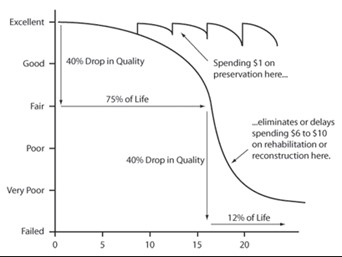Through a thoughtful asset management approach, the City of Ann Arbor makes informed, data-driven decisions about infrastructure investments.
What is asset management?
Asset management is a strategic approach to minimize operating costs by investing in preventative maintenance, repair, and rehabilitation of infrastructure to help assets last longer and stay in better condition.

This graphic illustrates a critical asset management concept: investing a small amount while infrastructure is still in reasonable condition will extend the asset lifespan and avoid exponentially higher investment needs as compared to waiting until the asset is in poor condition to invest.
Image source: www.planning.dot.gov
Good asset management helps to:
- Improve system performance by making necessary repairs to support on-going services
- Improve asset value by keeping systems in good condition longer
- Manage risk by addressing areas of concern to prevent infrastructure failure such as water main breaks, bridge closures, or pavement deterioration
- Make reliable decisions by evaluating data and following defined asset management goals, recommendations, actions and indicators
- Grow stakeholder confidence by communicating our needs and strategy behind the projects implemented
“By spending where and when it is necessary, rather than making expensive repairs when emergencies arise, asset owners can provide more reliable service and keep costs more affordable for rate payers" (Michigan Infrastructure Council 2023 Annual Report).
What infrastructure assets are managed by the City of Ann Arbor?
The city manages the structures that provide fundamental public services and allow our community to function:
- Streets, bridges, sidewalks, and bike lanes that get us where we need to go
- Underground water pipes that deliver clean, safe drinking water from the Water Treatment Plant to our faucets
- Underground sanitary pipes that collect everything from our sink drains and flushed toilets, and deliver it the Wastewater Treatment Plant
- Catch basins, detention basins, and underground stormwater pipes that collect rainwater and snow melt, to be infiltrated into the ground or conveyed to our creeks and the Huron River
- Manholes that allow work crews to provide underground pipe maintenance
- Streetlights and traffic signals that help us safely navigate
- and more!
 This sample graphic provides a snapshot of some assets managed by the City of Ann Arbor, including but not limited to roads, streetlights and water, sanitary and stormwater pipes.
This sample graphic provides a snapshot of some assets managed by the City of Ann Arbor, including but not limited to roads, streetlights and water, sanitary and stormwater pipes.What data helps determine how to best manage infrastructure assets?
Tracking data in each of these areas helps the City of Ann Arbor make better decisions:
- Performance: How well is the infrastructure delivering the desired level of service? What problems, or service interruptions, are experienced?
- Maintenance: What maintenance and repairs keep the infrastructure in working order? How frequently and at what cost?
- Operations and Personnel: How much attention/time is needed to maintain the asset, and do we have the staff capacity? How do the infrastructure needs compare to other high priority work?
- Infrastructure Life Cycle: How long do we expect the material to perform at the desired level of service? Will the material last longer if we make early investments before the infrastructure fails?
- Capital Planning: What total investments are required to keep essential public infrastructure functioning? How much funding do we expect will be available in future years? Which work is the highest priority, based on Ann Arbor’s overall values? (Learn more: a2gov.org/CIP)

This graphic uses icons to represent each of the ways data helps us make better asset management decisions, as described above.
